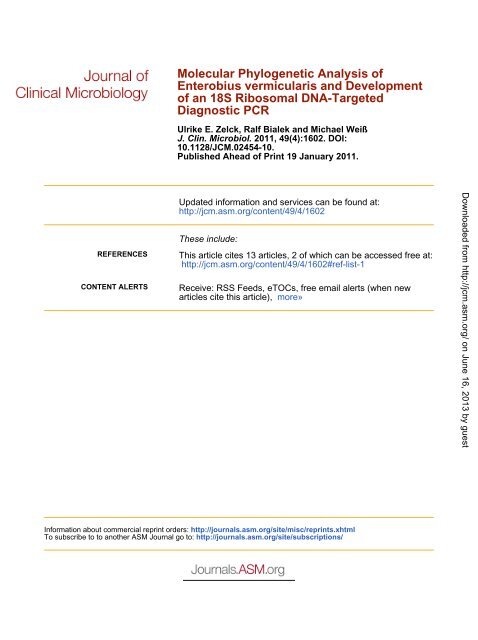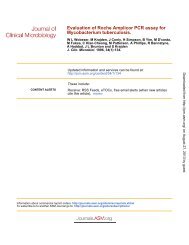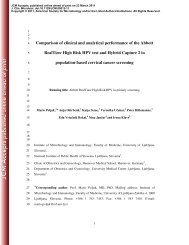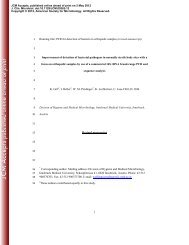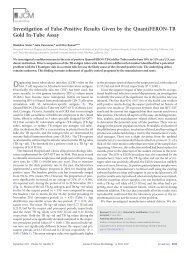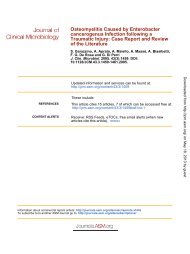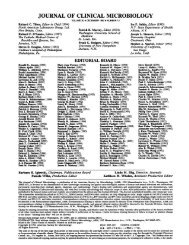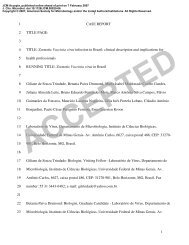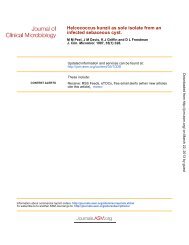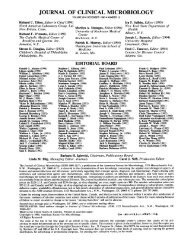Molecular Phylogenetic Analysis of Enterobius vermicularis and ...
Molecular Phylogenetic Analysis of Enterobius vermicularis and ...
Molecular Phylogenetic Analysis of Enterobius vermicularis and ...
You also want an ePaper? Increase the reach of your titles
YUMPU automatically turns print PDFs into web optimized ePapers that Google loves.
REFERENCES<br />
CONTENT ALERTS<br />
<strong>Molecular</strong> <strong>Phylogenetic</strong> <strong>Analysis</strong> <strong>of</strong><br />
<strong>Enterobius</strong> <strong>vermicularis</strong> <strong>and</strong> Development<br />
<strong>of</strong> an 18S Ribosomal DNA-Targeted<br />
Diagnostic PCR<br />
Ulrike E. Zelck, Ralf Bialek <strong>and</strong> Michael Weiß<br />
J. Clin. Microbiol. 2011, 49(4):1602. DOI:<br />
10.1128/JCM.02454-10.<br />
Published Ahead <strong>of</strong> Print 19 January 2011.<br />
Updated information <strong>and</strong> services can be found at:<br />
http://jcm.asm.org/content/49/4/1602<br />
These include:<br />
This article cites 13 articles, 2 <strong>of</strong> which can be accessed free at:<br />
http://jcm.asm.org/content/49/4/1602#ref-list-1<br />
Receive: RSS Feeds, eTOCs, free email alerts (when new<br />
articles cite this article), more»<br />
Information about commercial reprint orders: http://journals.asm.org/site/misc/reprints.xhtml<br />
To subscribe to to another ASM Journal go to: http://journals.asm.org/site/subscriptions/<br />
Downloaded from<br />
http://jcm.asm.org/<br />
on June 16, 2013 by guest
JOURNAL OF CLINICAL MICROBIOLOGY, Apr. 2011, p. 1602–1604 Vol. 49, No. 4<br />
0095-1137/11/$12.00 doi:10.1128/JCM.02454-10<br />
Copyright © 2011, American Society for Microbiology. All Rights Reserved.<br />
<strong>Molecular</strong> <strong>Phylogenetic</strong> <strong>Analysis</strong> <strong>of</strong> <strong>Enterobius</strong> <strong>vermicularis</strong> <strong>and</strong><br />
Development <strong>of</strong> an 18S Ribosomal DNA-Targeted<br />
Diagnostic PCR <br />
Ulrike E. Zelck, 1,2 Ralf Bialek, 2 * <strong>and</strong> Michael Weiß 3<br />
<strong>Molecular</strong> Parasitology Unit, Institute for Tropical Medicine, University <strong>of</strong> Tübingen, Wilhelmstraße 27, D-72074 Tübingen, 1<br />
Labor Dr. Krause & Kollegen MVZ GmbH, Steenbeker Weg 25, D-24106 Kiel, 2 <strong>and</strong> Organismic Botany, Institute <strong>of</strong><br />
Evolution <strong>and</strong> Ecology, University <strong>of</strong> Tübingen, Auf der Morgenstelle 1, D-72076 Tübingen, 3 Germany<br />
Received 7 December 2010/Returned for modification 14 December 2010/Accepted 10 January 2011<br />
We genetically characterized pinworms obtained from 37 children from different regions <strong>of</strong> Germany <strong>and</strong><br />
established new species-specific molecular diagnostic tools. No ribosomal DNA diversity was found; the<br />
phylogenetic position <strong>of</strong> <strong>Enterobius</strong> <strong>vermicularis</strong> within the Oxyurida order <strong>and</strong> its close relationship to the<br />
Ascaridida <strong>and</strong> Spirurida orders was confirmed.<br />
Pinworms are the most common intestinal parasites in developed<br />
countries in temperate climates (1). Humans are the<br />
only natural host <strong>of</strong> <strong>Enterobius</strong> <strong>vermicularis</strong>, <strong>and</strong> children are<br />
the most <strong>of</strong>ten affected by this disease, which is spread from<br />
the anus to mouth. Although it is regarded as a harmless<br />
infection, severe disease like colitis, perianal abscess, ectopic<br />
infections in females, <strong>and</strong> appendicitis can occur (1, 3, 12).<br />
Whereas eradication is achieved by anthelmintics in most cases<br />
(12), recurrent or persistent oxyuriasis lasting for years despite<br />
several treatment courses is seen in some patients. <strong>Molecular</strong><br />
tools might help to underst<strong>and</strong> transmission routes <strong>and</strong> distinguish<br />
persistent from repeated infections. However, sequence<br />
information on E. <strong>vermicularis</strong> is limited (6, 7).<br />
Pinworms were identified by examining feces from children<br />
with a magnifier, washed in tap water, <strong>and</strong> stored at 20°C.<br />
Then, pinworms from 37 children residing in different geographic<br />
regions <strong>of</strong> Germany were thawed <strong>and</strong> mechanically<br />
homogenized to extract DNA (Qiamp DNA minikit; Qiagen,<br />
Hilden, Germany). <strong>Enterobius</strong> <strong>vermicularis</strong> ribosomal DNA<br />
(rDNA) was amplified <strong>and</strong> sequenced as partially overlapping<br />
fragments using universal primers (AB28/TW81 <strong>and</strong> NEMF1/<br />
S3), degenerated nematode primers, <strong>and</strong> species-specific primers<br />
(Table 1). Amplification reaction mixtures (50 l) consisted<br />
<strong>of</strong> 100 nM (each) primer, 50 M (each) deoxynucleoside<br />
triphosphates (dNTPs), 2.5 mM MgCl 2, 0.5 units polymerase,<br />
<strong>and</strong> 10 l template. PCR amplification was performed as follows:<br />
(i) denaturation at 95°C for 5 min; (ii) 40 cycles, with 1<br />
cycle consisting <strong>of</strong> 60 s at 94°C, 60 s at 50 to 60°C, <strong>and</strong> 2 min<br />
at 72°C for 2 min, <strong>and</strong> (iii) a final extension step at 72°C for 10<br />
min. Amplification <strong>of</strong> 18S rDNA fragments for diagnostic purposes<br />
using <strong>Enterobius</strong>-specific primers Ev18S.F1 <strong>and</strong><br />
Ev18S.R1 was performed at 55°C under otherwise identical<br />
conditions. Products were detected on ethidium bromidestained<br />
agarose gels. PCR products were sequenced either<br />
directly or after gel extraction (QIAquick gel extraction kit;<br />
* Corresponding author. Mailing address: Labor Dr. Krause & Kollegen<br />
MVZ GmbH, Steenbeker Weg 25, 24106 Kiel, Germany. Phone:<br />
49 431 388 6590. Fax: 49 431 675160. E-mail: bialek@labor-krause.de.<br />
Published ahead <strong>of</strong> print on 19 January 2011.<br />
1602<br />
Qiagen, Hilden, Germany) <strong>and</strong> cloning (TOPO-TA; Invitrogen,<br />
Karlsruhe, Germany) using a BigDye terminator cycle<br />
sequencing kit <strong>and</strong> an ABI Prism 310 genetic analyzer (Applied<br />
Biosystems, Warrington, United Kingdom). Site polymorphisms<br />
were scored when alternative nucleotide peaks<br />
present were equal in height or when a minor peak significantly<br />
exceeded the background level <strong>and</strong> comprised 50% <strong>of</strong> the<br />
major peak. We amplified <strong>and</strong> sequenced the DNA <strong>of</strong> the<br />
small ribosomal subunit (18S rDNA, 1,716 bp), first <strong>and</strong> second<br />
internal transcribed spacer regions (ITS1 <strong>and</strong> ITS2, 1,073<br />
bp) including the 5.8S rDNA (159 bp), <strong>and</strong> a 78-bp fragment <strong>of</strong><br />
the large ribosomal subunit (28S). The complete 1,716-bp-long<br />
18S rDNA sequence was obtained from only 27 worms, <strong>and</strong> all<br />
37 ITS1-5.8S-ITS2 sequences were identical. Hence, our molecular<br />
analyses reveal no diversity <strong>of</strong> the genes examined to<br />
distinguish E. <strong>vermicularis</strong> isolates. Our result is in accordance<br />
with Iñiguez et al., who could not detect nucleotide differences<br />
within a 420-bp-long 5S rRNA sequence <strong>of</strong> seven pinworms<br />
TABLE 1. Primers used in PCR amplification <strong>and</strong> sequencing <strong>of</strong><br />
<strong>Enterobius</strong> <strong>vermicularis</strong> ribosomal DNA a<br />
Primer Position Sequence (5 to 3)<br />
TW81 3 end <strong>of</strong> the 18S rDNA GTT TCC GTA GGT GAA CCT GC<br />
AB28 5 end <strong>of</strong> the 28S rDNA<br />
(2812–2833)<br />
ATA TGC TTA AGT TCA GCG GGT<br />
NEMF1 376–393 CGC AAA TTA CCC ACT CTC<br />
S3 3 end AGT CAA ATT AAG CCG CAG<br />
SSU_F_01 5 end AAC CTG GTT GAT CCT GCC AGT<br />
SSU_R_26 927–907 CAT TCT TGG CAA ATG CTT TCG<br />
SSU_F_24 868–887 AGR GGT GAA ATY CGT GGA CC<br />
SSU_R_81 1817–1836 TGA TCC WKC YGC AGG TTC AC<br />
SSU_R_82 1817–1840 TGA TCC TTC TGC AGG TTC ACC TAC<br />
Ev18S.F1 1147–1166 AAC ACG GGA AAA CTC ACC TG<br />
Ev18S.R1 1341–1361 GCA CTG ACG GTT AAG CCA AT<br />
Ev18S.F2 445–464 CCG GTT ATC GGA ATG AGT GG<br />
Ev18S.R2 1024–1043 TTC CGG AGA GCT ACC AGC TA<br />
Ev18S.F3 963–982 CGC CCT AGT TCT GAC CGT AA<br />
Ev18S.R3 1539–1558 GGA GGA TTT TCA GGG GGT TA<br />
a The universal eukaryotic ITS primers TW81 <strong>and</strong> AB28 were used to amplify<br />
the ITS1-5.8S-ITS2 region; the nematode 18S consensus forward (F) primer<br />
NEMF1 was used with the universal eukaryotic reverse primer S3 (14). All<br />
small-subunit (SSU) primers were adapted from Nematode <strong>Phylogenetic</strong>s<br />
Primers (http://www.nematodes.org/barcoding/sourhope/nemoprimers.html).<br />
All Ev18S primers were designed based on the 18S ribosomal DNA sequence<br />
obtained in this study. R, reverse.<br />
Downloaded from<br />
http://jcm.asm.org/<br />
on June 16, 2013 by guest
FIG. 1. <strong>Phylogenetic</strong> placement <strong>of</strong> <strong>Enterobius</strong> <strong>vermicularis</strong> as derived from heuristic maximum likelihood analysis <strong>of</strong> an alignment <strong>of</strong> 18S rDNA<br />
sequences. The species is given first <strong>and</strong> then the GenBank (NCBI) accession number. The best tree found was rooted with Tylocephalus auriculatus<br />
<strong>and</strong> Plectus aquatilis. Branch lengths are given in terms <strong>of</strong> the estimated numbers <strong>of</strong> nucleotide substitutions per site. Asterisks mark branches that<br />
were scaled with factor 0.85 for graphical reasons. The numbers at the nodes are the maximum likelihood/maximum parsimony values. Branch<br />
support was calculated by maximum likelihood/maximum parsimony bootstrap from 1,000 replicates; values below 50% are designated by a <br />
symbol or omitted. Bar, 0.1 nucleotide substitution per site.<br />
1603<br />
Downloaded from<br />
http://jcm.asm.org/<br />
on June 16, 2013 by guest
1604 NOTES J. CLIN. MICROBIOL.<br />
from Brazil (6). The nonexistent genetic diversity might be due<br />
to excellent adaptation to the human host or low evolutionary<br />
pressure. However, analyses <strong>of</strong> less-conserved targets such as<br />
mitochondrial genes or the whole genome with for example<br />
r<strong>and</strong>omly amplified polymorphic DNA (RAPD) using worldwide<br />
isolates are required to further elucidate the genetic diversity<br />
<strong>of</strong> E. <strong>vermicularis</strong>.<br />
The small-subunit ribosomal DNA sequences were used to<br />
construct the molecular phylogeny <strong>of</strong> Nematoda (2, 9) where<br />
<strong>Enterobius</strong> <strong>vermicularis</strong> had not yet been included. Thus, we<br />
analyzed our 18S rDNA sequence together with other nematode<br />
sequences used by Nadler et al. (9) <strong>and</strong> published in<br />
GenBank (NCBI). This data set was aligned with DIALIGN<br />
(8). For phylogenetic reconstruction, we excluded those positions<br />
that received scores as low as 0 or 1 from the alignment.<br />
We ran maximum likelihood analyses using RaxML (11), involving<br />
rapid bootstrapping over 1,000 rounds <strong>and</strong> using every<br />
5th bootstrap tree as a starting point for heuristic search;<br />
GTRMIX was used as a DNA substitution model. Additional<br />
branch support was calculated using maximum parsimony<br />
bootstrap in PAUP* (13); we ran 1,000 bootstrap replicates,<br />
with 100 rounds <strong>of</strong> heuristic search per replicate starting from<br />
trees that resulted from subsequent addition <strong>of</strong> sequences in<br />
r<strong>and</strong>om order, treating gaps in the alignment as missing data<br />
<strong>and</strong> the multitree option not in effect. The maximum likelihood<br />
tree was rooted with Plectus aquatilis (GenBank<br />
[NCBI] accession no. AF036602) <strong>and</strong> Tylocephalus auriculatus<br />
(GenBank [NCBI] accession no. AF202155) <strong>and</strong> compared<br />
with previous molecular phylogenetic hypotheses (2, 4, 5, 9).<br />
Our analyses (Fig. 1) assigned E. <strong>vermicularis</strong> to the Oxyurida<br />
<strong>and</strong> confirmed previous studies showing that nematodes from<br />
the orders Ascaridida, Oxyurida, Rhigonematida, <strong>and</strong> Spirurida<br />
belong to a monophyletic group, informally designated<br />
“clade III” (2, 4, 9). Oxyurida is a highly supported monophyletic<br />
group (the maximum likelihood [ML] <strong>and</strong> maximum parsimony<br />
[MP] bootstrap values are 100 <strong>and</strong> 99, respectively),<br />
which appears as the sister group to a clade that includes<br />
Ascaridida <strong>and</strong> Spirurida.<br />
Although not useful to distinguish isolates, the 18S rDNA<br />
appears conserved enough for diagnostic purposes. Using our<br />
primers Ev18S.F1 <strong>and</strong> Ev18S.R1 (Table 1), a single product <strong>of</strong><br />
215 bp was successfully amplified <strong>and</strong> sequenced from 35 pinworms<br />
examined. All <strong>Enterobius</strong> <strong>vermicularis</strong> sequences were<br />
identical, showing 73.9% identity to 18S rDNA <strong>of</strong> Trypanoxyuris<br />
sciuri (Oxyurida), 71% identity to Oxyuris equi (Oxyurida), <strong>and</strong><br />
73% identity to Anisakis sp. (Ascaridida) when applied to NCBI<br />
Blast Search (15). No amplification was observed when DNA<br />
from adult Ascaris lumbricoides, Acanthocheilonema sp., or human<br />
DNA was examined.<br />
This PCR assay was used to examine 60 pieces <strong>of</strong> Scotch<br />
tape each fixed to a glass slide <strong>and</strong> sent to our lab for diagnosis.<br />
Typical pinworm eggs were identified by microscopy for only<br />
40. Then, pieces <strong>of</strong> the tape (1 to 1.5 cm by 1 cm) were cut <strong>and</strong><br />
scraped <strong>of</strong>f the glass slide using a sterile scalpel to avoid carryover<br />
contamination, <strong>and</strong> the eggs were transferred into tubes<br />
for DNA extraction as described above. DNA was amplified<br />
from all 40 microscopically positive samples <strong>and</strong> from three<br />
negative samples. No PCR product was obtained from the<br />
remaining 17 samples. Two <strong>of</strong> the three unexpected PCRpositive<br />
samples originated from samples from two children<br />
that gave positive results by microscopy <strong>and</strong> PCR in a second<br />
sample. The third false-positive sample was obtained from a<br />
household member <strong>of</strong> an infected child. It was concluded that<br />
the diagnostic PCR assay is at least as sensitive as microscopy<br />
(10). Pinworm eggs are usually deposited on the perianal skin<br />
<strong>and</strong> detected by the Scotch tape technique. Thus, they are very<br />
rarely found in fecal samples usually sent for parasitological<br />
diagnostics. At this time, we are organizing a comparative<br />
diagnostic <strong>Enterobius</strong> PCR study using DNA isolated from<br />
fecal samples <strong>and</strong> Scotch tape.<br />
In conclusion, we did not find any ribosomal DNA diversity<br />
<strong>of</strong> <strong>Enterobius</strong> <strong>vermicularis</strong> in Germany, we confirmed its phylogenetic<br />
position within Oxyurida, <strong>and</strong> developed a new species-specific<br />
diagnostic PCR which might identify more pinworm<br />
carriers than conventional tests.<br />
Nucleotide sequence accession number. The 2,867-bp sequence<br />
was deposited in GenBank (NCBI) under accession<br />
number HQ646164.<br />
The technical assistance <strong>of</strong> Ulrike Müller-Pinau <strong>and</strong> Andrea Dlugosch<br />
is highly appreciated. We thank two anonymous reviewers for<br />
very helpful suggestions <strong>and</strong> astute comments.<br />
REFERENCES<br />
1. Ariyarathenam, A. V., et al. 2010. <strong>Enterobius</strong> <strong>vermicularis</strong> infestation <strong>of</strong> the<br />
appendix <strong>and</strong> management at the time <strong>of</strong> laparoscopic appendectomy: case<br />
series <strong>and</strong> literature review. Int. J. Surg. 8:466–469.<br />
2. Blaxter, M. L., et al. 1998. A molecular evolutionary framework for the<br />
phylum Nematoda. Nature 392:71–75.<br />
3. Craggs, B., et al. 2009. <strong>Enterobius</strong> <strong>vermicularis</strong> infection with tuboovarian<br />
abscess <strong>and</strong> peritonitis occuring during pregnancy. Surg. Infect. 10:545–547.<br />
4. De Ley, P., <strong>and</strong> M. L. Blaxter. 2002. Systematic position <strong>and</strong> phylogeny, p.<br />
1–30. In D. L. Lee (ed.), The biology <strong>of</strong> nematodes. Taylor <strong>and</strong> Francis,<br />
London, United Kingdom.<br />
5. Feldman, S. H., <strong>and</strong> S. G. Bowman. 2007. <strong>Molecular</strong> phylogeny <strong>of</strong> the<br />
pinworms <strong>of</strong> mice, rats <strong>and</strong> rabbits, <strong>and</strong> its use to develop molecular beacon<br />
assays for the detection <strong>of</strong> pinworms in mice. Lab Anim. (New York) 36:<br />
43–50.<br />
6. Iñiguez, A. M., A. C. Vicente, A. Araúj, L. F. Ferreira, <strong>and</strong> K. J. Reinhard.<br />
2002. <strong>Enterobius</strong> <strong>vermicularis</strong>: specific detection by amplification <strong>of</strong> an internal<br />
region <strong>of</strong> 5S ribosomal RNA intergenic spacer <strong>and</strong> trans-splicing leader<br />
RNA analysis. E. <strong>vermicularis</strong>: specific detection by PCR <strong>and</strong> SL1 RNA<br />
analysis. Exp. Parasitol. 102:218–222.<br />
7. Kang, S., et al. 2009. The mitochondrial genome sequence <strong>of</strong> <strong>Enterobius</strong><br />
<strong>vermicularis</strong> (Nematoda: Oxyurida)–an idiosyncratic gene order <strong>and</strong> phylogenetic<br />
information for chromadorean nematodes. Gene 429:87–97.<br />
8. Morgenstern, B. 1999. Dialign 2: improvement <strong>of</strong> the segment-to-segmentapproach<br />
to multiple sequence alignment. Bioinformatics 15:211–218.<br />
9. Nadler, S. A., et al. 2007. <strong>Molecular</strong> phylogeny <strong>of</strong> clade III nematodes reveals<br />
multiple origins <strong>of</strong> tissue parasitism. Parasitology 134:1421–1442.<br />
10. Parija, S. C., C. Sheeladevi, M. R. Shivaprakash, <strong>and</strong> N. Biswal. 2001.<br />
Evaluation <strong>of</strong> lactophenol cotton blue stain for detection <strong>of</strong> eggs <strong>of</strong> <strong>Enterobius</strong><br />
<strong>vermicularis</strong> in perianal surface samples. Trop. Doct. 31:214–215.<br />
11. Stamatakis, A. 2006. RAxML-VI-HPC: maximum likelihood-based phylogenetic<br />
analyses with thous<strong>and</strong>s <strong>of</strong> taxa <strong>and</strong> mixed models. Bioinformatics<br />
22:2688–2690.<br />
12. St. Georgiev, V. 2001. Chemotherapy <strong>of</strong> enterobiasis (oxyuriasis). Expert<br />
Opin. Pharmacother. 2:267–275.<br />
13. Sw<strong>of</strong>ford, D. L. 2002. PAUP*. <strong>Phylogenetic</strong> <strong>Analysis</strong> Using Parsimony (*<strong>and</strong><br />
other methods), version 4b10. Sinauer Associates, Sunderl<strong>and</strong>, MA.<br />
14. Waite, I. S., et al. 2003. Design <strong>and</strong> evaluation <strong>of</strong> nematode 18S rDNA<br />
primers for PCR <strong>and</strong> denaturing gradient gel electrophoresis (DGGE) <strong>of</strong><br />
soil community DNA. Soil Biol. Biochem. 35:1165–1173.<br />
15. Zhang, Z., S. Schwartz, L. Wagner, <strong>and</strong> W. Miller. 2000. A greedy algorithm<br />
for aligning DNA sequences. J. Comput. Biol. 7:203–214.<br />
Downloaded from<br />
http://jcm.asm.org/<br />
on June 16, 2013 by guest


